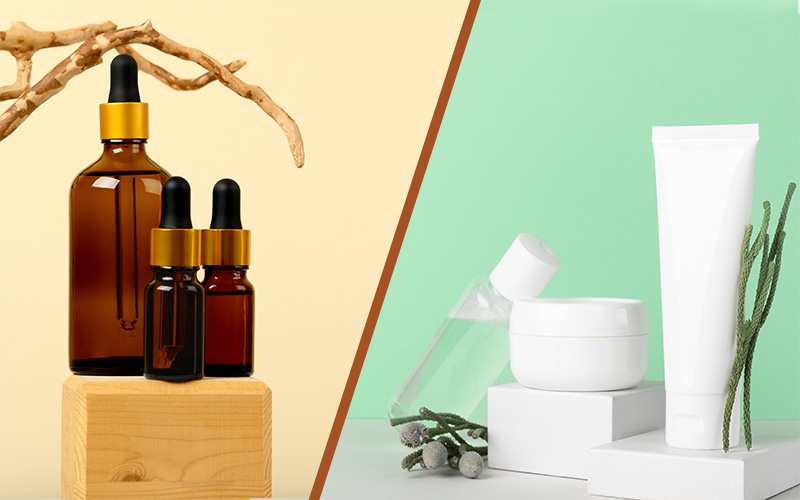There’s something visceral about glass. The heft, the clarity, the satisfying “clink” — it feels premium. Plastics, by contrast, are lightweight, versatile, and feel, well, common. But when you peel back the layers, the question is more than aesthetic — it’s about sustainability, safety, cost, and how your customers perceive your brand.
For small-batch soap and cosmetic makers, the decision often comes down to balancing ideals with practicality — and knowing when glass is truly worth the investment.
Sustainability, Recycling, and Environmental Impact
When it comes to the planet, both materials have pros and cons — and their total impact depends on where and how they’re made, how they are transported, and if they can be recycled or reused.
Cradle-to-Cradle Sustainability
The ideal of cradle-to-cradle design is that a material can be reused, recycled, or repurposed indefinitely without losing its quality or becoming waste. In other words, the “end” of one product’s life becomes the “beginning” of another — creating a continuous loop rather than a one-way trip to the landfill.
- Glass comes closest to that ideal. It’s made from natural materials (sand, soda ash, limestone) and can be endlessly melted and re-formed without loss of purity. When recycled properly, it even reduces the energy needed to make new glass.
- Plastic, in contrast, typically follows a cradle-to-grave path. Even when recycled, most plastics are downcycled into lower-quality materials or products that can’t be recycled again. Plus, only a small percentage of plastic packaging actually gets recycled in the U.S. — much ends up in landfills or as microplastics in the environment.
Where They’re Made and Why It Matters
Where the material is made determines how far it has to go to get to you. The longer the distance, the more environmental impact from transportation — whether it is by ship, plane, train, or truck.
- Glass production is energy-intensive and requires large furnaces that melt raw materials at over 2,500°F.
In the U.S., there are some glass manufacturing companies in the Midwest and Southeast — close to sand and soda ash deposits — that make stock-type glass containers for food, beverages, cosmetics, and candles. While there are some higher-end glass producers in the US, those are often made in Europe (France, Italy, Czech Republic) or Asia (China). And, of course, the biggest quantity and cheapest products come from China. Shipping that heavier glass adds to its carbon footprint. - Plastic containers take less energy to make. They are produced all over the world, but the U.S.does have some blow-molding facilities. However, Asian suppliers dominate large-scale, low-cost production. Again, that transportation cost can be impactful.
Energy, Emissions, and Waste
- Glass requires more energy to produce initially but can be recycled infinitely.
- Plastic requires less energy to make but rarely achieves full recycling loops.
- Transporting glass adds weight (and emissions), while plastic wins in logistics efficiency.
- Disposal of plastics often leads to persistent waste and microplastic pollution — something glass avoids.
In short: Glass is more sustainable if it’s recycled or reused; plastic is lighter and cheaper but harder to truly reclaim.
As a side note, in my area we no longer have pick-ups for glass recycling.
Durability, Safety, and Practical Use
Glass and plastic perform differently in real-world handling. That matters when choosing a container for a particular use, when you need to ship long distance, or when you’re carting products around for shows.
General Use and Customer Safety
When you’re considering your customers use of your product, sometimes safety can be a factor.
- Glass: When used in the bathroom (usually with hard surfaces), glass can be an issue. It can drop and break – a bad situation in a shower or tub! On the other hand, a delicate perfume bottle on a dresser is unlikely to cause a problem.
- Plastic: Unlikely to break, making it ideal not only for bathrooms, but for travel.
Durability and Chemical Safety
While a general cosmetic product isn’t intended to last forever (you want the customer to use it up!), how well it holds up is definitely a factor. I once got some marvelous plastic “test tubes” to package scented bath salts in. It was all well and good for a while, but then the fragrance and essential oils began to slowly melt them. In the end, I had to toss all the product in those containers.
- Glass: It’s inert and won’t leach chemicals into the product, react to ingredients, or absorb fragrance or essential oils. In most cases, you can be pretty sure it will work with your product.
- Plastic: It isn’t inert, may leach chemicals into the product, will often react to ingredients and can easily absorb fragrance oils. Some types of plastic will even degrade in sunlight. Whenever you use plastic bottles or jars, you should test to make sure they will work with your product. (And that also applies to caps, closures, and seals that are used on glass jars.)
Longevity
Longevity is another factor to consider, especially if you are considering any type or refill or reuse program.
- Glass: It can be reused indefinitely if it’s not broken. It can be sterilized for a new or different use. If you want to institute a refill or return program, glass is likely the best way to go. Besides that, consumers may find their own ways to reuse glass jars or bottles to keep them out of the landfill or recycling system.
- Plastic: It tends to scratch, discolor, and degrade after repeated use or washing. It can’t be sterilized and so there could be safety concerns with a refill or return program. Consumers are less likely to keep and reuse plastic bottles or jars.
Cost and Availability
Obviously, cost and availability are major factors for small makers. Even if you are willing to pay a higher price, if what you want isn’t available to you, it doesn’t matter.
Available Choices
You are most likely to need to purchase by the dozen or by the case — but not by the container or custom run.
That means you’ll have to choose from the stock products generally available from suppliers. It’s likely to be the standard items: straight wall glass or plastic jars, Boston round bottles, etc.
- Glass: There tend to be fewer stock options for glass bottles and jars, and many of them are designed for the food industry. Small(ish) quantities of perfume or specialty bottles may be available, but sometimes it takes some searching if you want something different than what’s normally available. Glass containers may require higher order minimums.
- Plastic: There are usually more options available for stock plastic containers — not only in size and style, but also in color.
There are companies that sell “overages,” so it is possible to get fancier glass containers or plastic containers in a unique color or shape. However, these are usually limited (“while supplies last”) or require that you purchase the whole batch. This can be great for getting a stand-out product, but it’s also a gamble because once the supply is gone, you won’t be able to get more. (What happens if it’s a run-away hit!?)
Upfront cost:
- Glass: Generally more expensive per piece and requires more packaging (sturdier boxes with dividers or cushioning). Case sizes may be smaller due to the weight. Shipping from the manufacturer to the supplier is already factored into the price, but shipping from the supplier to you can be a definite factor.
- Plastic: Less expensive per unit. Less packaging (often just tossed into a box). May have higher case quantities to qualify for discounts. They are also lighter, which means less shipping cost to get to you (unless they are too light – and then then can hit oversize charges!)
- Minimum order quantities: Plastic bottles and jars are widely available in small batches from U.S. distributors. Glass containers may require higher order minimums or more specialized packaging.
- Decorative finishes: Plastic can be molded in nearly any color or shape; glass offers a premium, upscale feel but fewer budget options.
Consumer Perception and Brand Image
Perception plays a huge role. To many consumers, glass = natural, premium, and sustainable, while plastic = practical, affordable, and convenient.
For artisan brands, glass can elevate perceived quality and align with eco-friendly values. For products aimed at daily use or affordability, plastic may fit better.
However, while surveys show U.S. buyers consistently view glass packaging as more sustainable — they often prioritize price and convenience in actual purchase decisions.
Comparison Chart: Glass vs. Plastic
| Category | Glass | Plastic |
|---|---|---|
| Sustainability / Recycling | ✅ Cradle-to-cradle recyclable | ❌ Limited recycling rates |
| Production | ❌ High energy to produce | ✅ Lower production energy |
| Trasportation | ❌ Higher trasportation emissions | ✅ Lower transportation emissions |
| Safety | ❌ Fragile; can chip or shatter | ✅ Tough, shatter-resistant |
| Reusability | ✅ Can last forever with care | ❌ Degrades quickly |
| Chemical Safety | ✅ Inert | ❌ Possible migration; can react |
| Cost | ❌ More expensive per unit | ✅ Low cost, easy to source |
| Aesthetic / Brand Perception | ✅ Premium, sustainable, high-end | ✅ Practical and economical ❌ Perceived as less eco-friendly |
| Stock Availability | ✅ Basic containers available | ✅ Basic containers available |
| Made in the USA | ✅ May be; verify sourcing | ❌ Most likely China |
When Glass Is Worth the Investment
Glass can be worth the higher cost when:
- You sell premium or natural products where packaging quality reinforces your brand image.
- The product is used in a location and way where it is unlikely to break.
- You want reuse or refill options that emphasize sustainability.
- Your cater to local customers (reducing transport costs and breakage risk) (or high-end customers who don’t mind the extra cost that has to be factored in).
- You have access to reliable glass recycling or take-back programs.
- You want to avoid plastic leaching concerns — especially with essential oils or active ingredients.
Checklist: Choosing What’s Best for Your Product Line
For small-batch makers, the “right” choice depends on your product, your customer, and your priorities. Use this checklist to guide your decision:
- ✅ Product Compatibility — Will the container safely hold your formula (no leaching, no reaction)?
- ✅ Customer Use — Are your buyers likely to drop or travel with it?
- ✅ Brand Image — Does your brand lean eco-luxury (glass) or accessible and practical (plastic)?
- ✅ Weight & Shipping — Can you afford the cost and risk of heavier glass in shipping?
- ✅ Recycling Reality — Does your region actually recycle glass or plastics effectively?
- ✅ Refill / Reuse Options — Can you build a return or refill program?
- ✅ Budget & Pricing — Will your packaging costs align with your retail price point?
If your answers lean toward premium, local, reusable, and natural — glass may be your winner.
If they point toward practical, affordable, lightweight, and travel-friendly — plastic makes sense.
In the end, sustainability isn’t just about the material — it’s about how you design, source, and reuse your packaging, and what happens to it after the customer is done with it. Choose the option that best fits your brand values and your customers’ everyday reality.


Leave a Reply